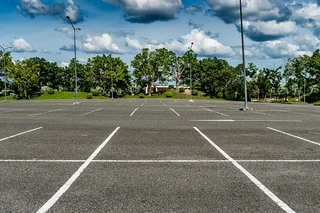The stripes in your parking lot have seen better days and if you wait much longer, visitors won’t be able to tell where one parking stall ends and another begins. Decades ago, there would only be one or two choices for the type of traffic paint used to stripe parking lots. Today, however, competition and innovation have given way to a multitude of line striping paints specifically formulated for different weather, vehicle traffic intensity, and regulatory environments. What type of paint is right for you? Considering these factors will help you choose the best traffic paint for your needs.
1. VOC Regulations
Consumers have become more environmentally conscious across industries, and traffic paint is no exception. Federal regulations under the Clean Air Act require that traffic-marking paints contain no more than 150 g/l VOCs. Many states and municipalities have set more stringent VOC standards for traffic paint, including California’s South Coast Air Quality Management District (SCAQMD), which sets the most stringent limit at 100 g/l VOC. In addition, many areas have outlawed solvent-based traffic paints.
Fortunately, the market for eco-friendly traffic paints has matured to offer high-performance products at comparable prices to traditional paints. If you live in an area with stringent VOC regulations that still allow solvent-borne paints to be sprayed, you might consider a low VOC acrylic zone marking paint. For areas where solvent-based traffic paint is outlawed, there are plenty of low VOC waterborne traffic paints that do a fine job, including some that utilize bio-renewable components.
2. Weather Conditions
Weather, both at the time the paint is applied, and throughout the course of the year, must be considered when selecting traffic paint. Most waterborne paints are especially sensitive to humidity, as their drying and curing mechanisms depend on water leaving the system. Heightened humidity and low temperatures make it difficult for this water to escape and achieve a full dry. Without a complete dry, it is important to keep traffic off your lot in order to avoid paint tracking off onto peoples’ tires.
Post-application, your paint should be suitable for your climate. For example, if you live in an area that experiences snowfall, your paint will need to stand up to the salt, snowplow traffic, and freeze-thaw that comes with it. If you live in an area that receives a high concentration of UV light, you’ll need paint with high quality pigments that will not chalk out under ultraviolet conditions.
3. Cost and Restriping Frequency
Generally, there is a direct relationship between cost per gallon and longevity of traffic paint. This is because the primary price driver for line striping paint is raw materials, and higher quality raw materials, primarily resins and pigments, yield better, longer lasting paints. Cheaper paints tend to flake off, chalk out, and get dirty (reword) in less than a year, often requiring restriping once every summer.
High performance traffic and zone marking paints, however, are engineered to last multiple years, with some methyl methacrylate paints lasting as long as a decade. In most cases, about 35 percent of what striping contractors charge for restriping a lot is material costs associated with the paint, with the remaining 65 percent going toward labor, overhead, and profit. Some quick math demonstrates the lifecycle costs of striping with paints of varying prices and qualities.
Regular |
2 Year |
3 Year |
||||
Year |
Material Cost |
Labor/Overhead/Profit |
Material Cost |
Labor/Overhead/Profit |
Material Cost |
Labor/Overhead/Profit |
| 1 | $1.00 | $1.86 | $1.67 | $1.86 | $2.45 | $1.86 |
| 2 | $1.00 | $1.86 | $0.00 | $0.00 | $0.00 | $0.00 |
| 3 | $1.00 | $1.86 | $1.67 | $1.86 | $0.00 | $0.00 |
| 4 | $1.00 | $1.86 | $0.00 | $0.00 | $2.45 | $1.86 |
| 5 | $1.00 | $1.86 | $1.67 | $1.86 | $0.00 | $0.00 |
| 6 | $1.00 | $1.86 | $0.00 | $0.00 | $0.00 | $0.00 |
| 7 | $1.00 | $1.86 | $1.67 | $1.86 | $2.45 | $1.86 |
| 8 | $1.00 | $1.86 | $0.00 | $0.00 | $0.00 | $0.00 |
| 9 | $1.00 | $1.86 | $1.67 | $1.86 | $0.00 | $0.00 |
| 10 | $1.00 | $1.86 | $0.00 | $0.00 | $2.45 | $1.86 |
| Paint Cost | $10.00 | $8.34 | $9.81 | |||
| TOTAL | $28.57 | $17.62 | $17.23 |
As you can see, over time, striping with higher performance traffic paint results in considerable life cycle cost savings, despite the greater per gallon material cost for paint. This savings is greater when an outside contractor does the striping since labor and other non-material costs are avoided. Even for organizations that do their own painting, however, striping with high-quality traffic paint also results in savings on paint costs over time. Although higher quality paint is more expensive per gallon, your organization will require less paint to keep your parking stalls and other pavement markings visible.
If you are looking to stripe your parking lots less often, look no further than Aexcel Corporation. For over 50 years, we have been expanding our traffic paint portfolio to accommodate changes in VOC regulations and solvent restrictions with high-performance traffic paints. And recently, our chemists formulated BioStripe®, a sustainable traffic paint made from natural soybean oil, to satisfy requirements of the USDA BioPreferred Program and provide our customers with a green alternative to traditional paints.

